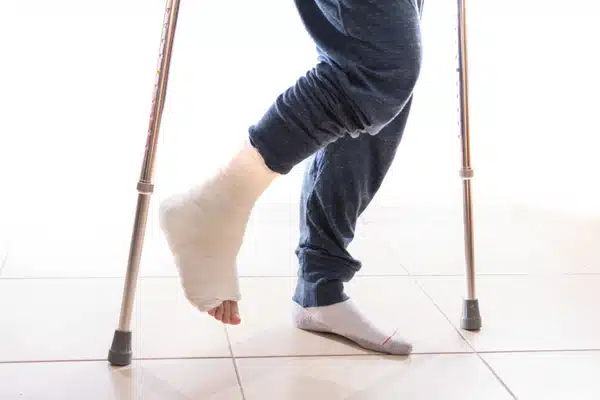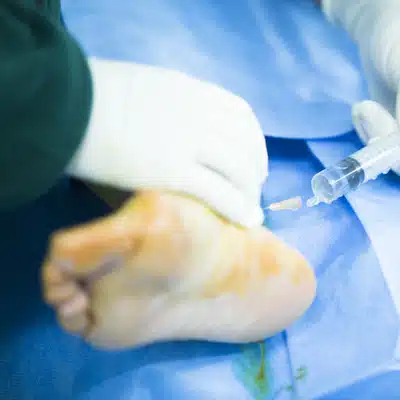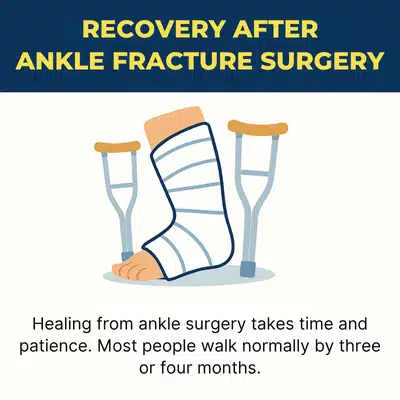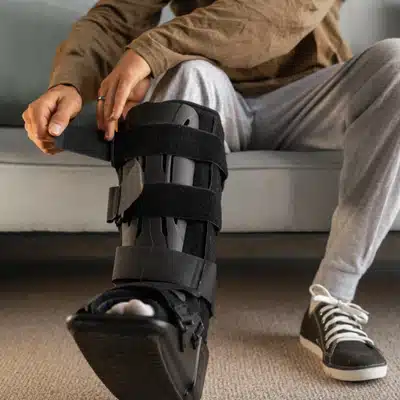
An ankle fracture means one or more bones in your ankle joint are broken. This common injury affects thousands of people each year. While some ankle fractures heal with a cast, others require surgery to fix the broken bones properly.
Understanding when you need ankle fracture surgery and what to expect can help you make informed decisions about your care.

Your ankle joint contains three bones. The tibia forms the inner side, the fibula creates the outer side, and the talus connects to your heel bone. Strong ankle ligaments hold these bones together.
Ankle fractures happen when trauma damages one or more of these bones. Common causes include sports injuries, falls, car accidents, or simply stepping wrong. The injury can range from a simple crack to multiple breaks with torn soft tissues.
Signs of a fractured ankle include sudden severe pain, swelling, and being unable to put weight on the injured ankle. You might also see bruising or notice your ankle looks deformed.
Doctors diagnose ankle fractures using X-rays. Sometimes they need CT scans or MRI to see all the damage to bones and soft tissues.
Different types of ankle fractures affect different bones:
Lateral malleolus fracture breaks the fibula on the outside of the ankle.
Medial malleolus fracture splits the tibia’s inner edge, often showing a painful bump and ankle deformity. Posterior malleolus fracture involves the back of the tibia and may scatter bone fragments.
Bimalleolar fracture shatters both outer and inner bones, while bimalleolar equivalent combines one break with ligament damage, leaving the joint equally unstable.
Trimalleolar fracture injures all three malleolus fractures, demanding open reduction with hardware under anesthesia, usually at an outpatient surgery center.
Early pain management, careful weight bearing guidance, and physical therapy restore mobility and healing after fixation.

Not every broken ankle needs surgery; small fractures that stay often heal in a cast. Surgery is advised when bone pieces are displaced, multiple bones break, the fracture enters the joint, or ligament damage creates ankle instability. Open fractures also require urgent clean out and fixation.
Modern surgical techniques use small incisions to realign bones, fix a syndesmosis injury, and perform tendon repair when needed. Metal plates, hardware, and screws hold the ankle steady so weight bearing can resume safely during the healing process. Early motion exercises protect range of motion, while thinners reduce deep vein thrombosis risk and aid recovery.
Ankle fracture surgery relies on open reduction and internal fixation. After anesthesia the surgeon makes small incisions, exposes the break, and realigns the fragments.
Internal fixation follows: a plate and screws secure a lateral malleolus fracture along the fibula, while a medial malleolus break receives screws or a mini-plate. If ligaments are torn or a syndesmosis injury is present, a trans-syndesmotic screw holds the tibia and fibula together to protect bone healing.
In-surgery X-rays confirm alignment, then the wounds are closed and the ankle placed in a splint or walking boot. Complications are rare, and hardware usually remains permanently.

Healing from ankle surgery takes time and patience. Your recovery happens in stages:
First six weeks after anesthesia wears off, keep all weight off the repaired ankle. Use crutches or a knee scooter, elevate the leg above heart level, apply ice, and watch the incision for infection.
A splint or cast protects fixation, especially if arthroscopy, tendon repair, or syndesmosis injury complicated surgery.
At six to twelve weeks, X-rays confirm healing, then gradual weight bearing begins, often in a walking boot. Physical therapy minimizes scar tissue, restoring range, strength, and balance.
Most people walk normally by three or four months, though sports may wait six months and complex fractures can require a year.

Several steps help ensure successful recovery:
Follow weight-bearing rules strictly. Bearing weight too early can shift the break, especially with malleolus fractures, leading to poor healing.
Manage swelling and pain: elevate, ice, and take pain medication as prescribed. Keep the incision clean and dry, watch for infection, and attend every follow-up visit.
Prevent blood clots with ankle pumps, compression stockings, and prompt reporting of calf pain. Good nutrition with protein, calcium, and vitamin D speeds bone repair.
Do not smoke because it slows recovery. Stick to physical therapy to restore motion and strength.
These steps help patients with malleolus fractures or syndesmosis injury return to normal activities quickly.
Modern ankle fracture treatment offers excellent results for most patients. Surgical methods continue to improve, giving doctors better ways to fix broken bones and speed recovery.
The key is getting proper treatment quickly. Delayed care can lead to poor healing and long-term ankle pain. If you suspect an ankle fracture, seek medical attention right away.
Your orthopedic surgeon will explain all treatment options based on your specific injury. They consider factors like your age, activity level, and overall health when recommending surgery or other approaches.
Remember that recovery takes time, but most people regain full function of their ankle joint. With proper care and dedication to rehabilitation, you can expect to return to all the activities you enjoyed before your injury.
Don't let ankle pain control your